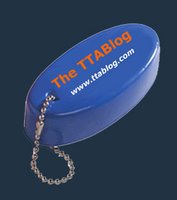TTABlog Quarterly Index: July - September 2013
E-mail subscriptions to the TTABlog are available. Just enter your e-mail address in the box on the right to receive a daily update via Feedblitz. You may also follow the blog on Twitter (here). And don't forget to leave your comments! [Note that E-mail subscribers must go to the blog to see comments]. Finally, please report any broken or inoperative links, as well as any errors and omissions, to the TTABlogger at jwelch at lalaw.com.
Section 2(a) - Deceptiveness:
Section 2(a) - Disparagement:
- Precedential No. 31: TTAB Dismisses U. Alabama Opposition to HOUNDSTOOTH MAFIA & Design for Clothing
- Precedential No. 31: TTAB Dismisses U. Alabama Opposition to HOUNDSTOOTH MAFIA & Design for Clothing
- Precedential No. 34: Findng "AWSHIT WORKS" to be Scandalous, TTAB Affirms Section 2(a) Refusal
- Test Your TTAB Judge-Ability: Is "I BANGED BETTY" Scandalous or Immoral Under Section 2(a)?
Section 2(d) - Likelihood of Confusion:
- Test Your TTAB Judge-Ability: Are REAL CHOICE and CLEARCHOICE DENTAL IMPLANTS Confusable for Implant Services?
- WYHA? Section 2(d) and Faulty Specimen Refusals Sink SCARLET Wine Application
- WYHA? TTAB Affirms Section 2(d) Refusal of BLUE STAR POWER SYSTEMS Over BLUE STAR for Generators
- Test Your TTAB Judge-Ability: Which Two of these Four Section 2(d) Refusals Were Reversed?
- Finding Living Plants Unrelated to Furniture Fabrics, TTAB Dismisses SUNBRELLA Opposition to SUN BRELLA'S
- Coach Loses Section 2(d) Design Mark Battle
- Test Your TTAB Judge-Ability on These Three Section 2(d) Appeals
- Test Your TTAB Judge-Ability: Are EWETOPIA and UTOPIA Confusable for Yarn?
- EDGECRAFT Proves Actual Confusion, TTAB Cancels EDGEWARE Registrations for Sharpeners
- Test Your TTAB Judge-Ability: Are NUTFFLES and P-NUTTLES Confusable for Candy?
- Precedential No. 31: TTAB Dismisses U. Alabama Opposition to HOUNDSTOOTH MAFIA & Design for Clothing
- TTABlog Uncorked: Collection of Section 2(d) Cases Involving Wine (Updated)
- Precedential No. 26: Finding Wine and Water Related, TTAB Sustains 2(d) Opposition
- FACEMAIL Falls on its Face When Faced with Famous FACEBOOK Mark
- Test Your TTAB Judge-Ability: Are C•PREME and SUPREME Confusingly Similar for Bicycles?
- Test Your TTAB Judge-Ability: Are Prepared Alcoholic Cocktails Related to Beer?
- Test Your TTAB Judge-Ability: Are "THE TEAM, THE TEAM, THE TEAM" And "TEAM" Confusable for Athletic Footwear?
- Test Your TTAB Judge-Ability: Is STACKED Merely Descriptive of Wine?
- Precedential No. 37: TTAB Affirms Mere Descriptiveness Refusal of SUPERJAWS for Machine and Hand Tools
- WORLD COIN NEWS Not Generic But Merely Descriptive for Coin-Related Magazines, Says TTAB
- Test Your TTAB Judge-Ability: Which One of these Four Mere Descriptiveness Refusals Was Reversed?
- Test Your TTAB Judge-Ability on These Three Mere Descriptiveness Refusals
- WYHA? TTAB Finds CASINO INFO Generic and/or Merely Descriptive of ... Guess What?
- Precedential No. 27: TTAB Rejects Genericness and Fraud Claims, But Cancels "ANNAPOLIS TOURS" Section 2(f) Registration for Mere Descriptiveness
- Test Your TTAB Judge-Ability: Is IPEN Merely Descriptive of Digital Pens?
- Test Your TTAB Judge-Ability: Is "CARBON AUDIO" Merely Descriptive of Loudspeakers?
- Precedential No. 29: TTAB Affirms Five (5) Refusals of "AOP" for Wine
Section 2(e)(4) - Primarily Merely a Surname:
Section 2(e)(5) - Functionality:
- Precedential No. 32: TTAB Sustains Opposition to Pipe Boot Design, Finding it De Jure Functional
- TTAB Reverses Section 2(e)(5) Functionality Refusal of "3-click" Sound Mark for Eyeglasses
Failure to Function:
- Precedential No. 29: TTAB Affirms Five (5) Refusals of "AOP" for Wine
- TTAB Affirms Refusal to Register Non-Distinctive Product Design/Packaging for Clothing
- TTAB Finds No Fraud in 2008 Specimen of Use for Section 1(a) Application Filed in 2007
- TTAB Summarily Dismisses Two Fraud Claims in INTELLOGY Fracas
- Precedential No. 27: TTAB Rejects Genericness and Fraud Claims, But Cancels "ANNAPOLIS TOURS" Section 2(f) Registration for Mere Descriptiveness
- Precedential No. 28: TTAB Denies 12(b)(6) Motion to Dismiss Fraud Counterclaim
- TTAB Denies Petition to Cancel MUMBO Registration for Barbeque Sauce
- CAFC Affirms TTAB: "PRASTERONE.ORG" Generic for Prasterone-Related Website
- WORLD COIN NEWS Not Generic But Merely Descriptive for Coin-Related Magazines, Says TTAB
- Precedential No. 36: TTAB Finds FOOTLONG To Be Generic for Sandwiches
- Precedential No. 27: TTAB Rejects Genericness and Fraud Claims, But Cancels "ANNAPOLIS TOURS" Section 2(f) Registration for Mere Descriptiveness
- Genericness Counterclaim Demolishes ROCKSCAPE Registration for Landscaping Stone
Lack of Bona Fide Intent:
Morehouse Defense:
Ownership:
Priority:
- TTAB Dismisses "GREAT SEATS" 2(d) Opposition Due to Failure to Prove Priority
- Sale to Single Foreign Customer Sufficient for Priority, Says TTAB
Section 10 Assignability:
Discovery/Evidence/Procedure:
- Precedential No.35: TTAB Denies Protective Order, Requires Opposer to Answer Hundreds of Admission Requests
- Precedential No. 28: TTAB Denies 12(b)(6) Motion to Dismiss Fraud Counterclaim
- Precedential No. 30: TTAB Re-Designates as Precedential Its Opinon Vacating ROLEX/ROLL-X
Recommended Reading:
- Recommended Reading: LaLonde and Gilson, "The United States Supplemental Register: Solace, Substance, or Just Extinct?"
- Jerre B. Swann, "The Evolution of Dilution in the United States from 1927 to 2013"
- TTABlogger Article: "The Top Ten TTAB Decisions of 2012-2013" - Plus 40% Discount on "The IP Book"
- USPTO Seeks Feedback Regarding Post-Registration Amendment of I.D.s Due to Evolving Technology
- TTAB Posts September 2013 Hearing Schedule
- TTABlog September Road Trip: Ohio Double-Header at AOAIOIP in Cincinnati and Cleveland
- TTAB Posts August 2013 Hearing Schedule
- TTAB Posts July 2013 Hearing Schedule











































